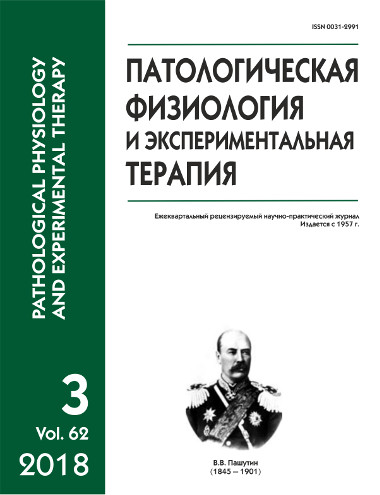Liver resection transforms mechanisms of renal ammonia excretion in rats with chronic tetrachloromethane-inducedd hepatitis
Abstract
Mechanical (resection) or toxic (hepatitis) liver damage alone has an ambiguous effect on renal ammonia excretion during development of endogenous ammonia intoxication. The aim. The study investigated the effect of liver resection (LR) on renal ammonia excretion in chronic tetrachlorocarbon (CCl4)-induced hepatitis. Methods. Experiments were conducted on 240 mongrel white rats (females) weighing 180—220 g. Chronic hepatitis was induced by subcutaneous injection of 50% solution of carbon tetrachloride (CCl4) in olive oil (0.1 ml/100g body weight per day with two two-week breaks between injections 6—7 and 13—14). LR with removal of a part of the left lobe (15—20% of body weight) was performed on the 65th (last) day of CCl4 injections. The animals were examined on the 3rd, 7th and 14th day after LR or laparotomy (sham operation). Contents of ammonia (AM), glutamine (GN), and urea were measured in the kidney, arterial (AB) and venous (v.renlis) blood, and urine. Results. Progression of endogenous ammonia intoxication after LR associated with CCl4-induced hepatitis and increased renal excretion of Am involves three mechanisms: 1) excretion of Am that is delivered to kidneys in the free form with AB; 2) stimulation of renal tubule secretion of Am that had formed in kidneys by deamidation of «arterial» Gn; and 3) contrary to rules, partial reabsorption of Am from collecting tubules into the blood. However, this does not eliminate arterial hyperammonemia or prevent accumulation of Am in kidneys. The stimulatory effect of LR in CCl4-induced hepatitis on Gn incretion from kidneys to the circulation stops by the 14th day after surgery, and the accompanying increased consumption of Gn from AВ results in Gn accumulation in kidneys. LR stimulates urea excretion with urine and simultaneously activates kidney formation of urea, which further enters the bloodstream and urine. Depending on the postoperative period this is associated with changes in the rate of urea reabsorption in kidneys. Conclusions. In RP associated with CCl4-induced hepatitis, kidneys cannot prevent progression of endogenous ammonia intoxication and pathological accumulation of ammonia and glutamine in kidney cells but retain the ability to participate in the regulation of the increased urea level in AB.
Downloads
References
2. Savilov P.N. Ammonia neutralization function liver in chronic active hepatitis Patologicheskaya Fisiologiya I Experimentalnaya Terapiya 2004; 1: 24-6. (in Russian)
3. Reshetnyak V.I. Liver cell failure. Obchaya Reanimatologiya. 2005; 1(3): 68-79. (in Russian)
4. Kosenko E.A., Kaminsky Y.G. Cellular mechanisms of ammonia toxicity [Kletotchniye mekanizmi toksitchnosti ammiaka]. Мoscow; LKI, 2008. (in Russian)
5. Savilov P.N., Molchanov D.V. Kinetics of ammonia in the body in chronic hepatitis partial hepatectomy and hyperbaric oxygenation Jurnal teorethitcheskoy i prakthitcheskoy meditsiny — Voronezh. 2010; 8(2): 211-6. (in Russian)
6. Schricker A., Abuszies G., Weidenbach H., Beck K.H., Ensinger H., Geiser W., Adler G., Georgieff M. Harnstoff und Glukosenproduction der Leber beim Patienten mit alkocholinduzierte Zirrhose Detsch. Med.Wschr.1997; 122(4): 75-9.
7. Savilov P.N., Molchanov D.V., Yakovlev V.N. The effect of hyperbaric oxygenation on the kinetics of glutamine in the body when liver failure Obchaya Reanimatologiya. 2012; 8(2): 20-7. (in Russian)
8. Savilov P.N. The state of nitrogen metabolism in thyroid gland tissue in chronic hepatitis Meditsina Kirgizstana. 2012; 6: 68-72.
9. Savilov P.N. Nitrogen metabolism in the spleen in chronic hepatitis tetrachlorocarbon. Biologitcheskiy zhurnal Armenii. 2015; 67(2): 6-11.
10. . Molchanov D. V., Savilov P. N. Renal mechanisms of elimination of ammonia after liver resection (experimental study). Rossiyskiy vestnik detskoy hirurgii, anestesiologii I reanimatilogii. 2013; 3(3): 64-8. (in Russian)
11. Savilov P.N.., Molchanov D.V. Kinetics of nitrogenous metabolites in the kidney during tetraclormetane hepatitis. Patologicheskaya Fisiologiya I Experimentalnaya Terapiya. 2014; 2: 56-60. (in Russian)
12. Pyshkin S.A., Malyshev Yu.I., Dimov P.G. Indications for surgical treatment of chronic hepatitis and liver cirrhosis. Klinitcheskaya khirurgia 1986; 9: 29-32. (in Russian)
13. Rivnyak V.I. Extracellular breakdown of collagen under the action of lysosomal enzymes during involution of liver cirrhosis. Bulleten Eksperimentalnoy Biologii I Meditsiny. 1986; 12: 760-3. (in Russian)
14. Savilov P.N. Influence of partial hepatectomie on ammoniumdetoxications function of liver at chronic tetrachlorcarbon hepatitis. Patologicheskaya Fisiologiya I Experimentalnaya Terapiya. 2017; 61(2): 61-6. (in Russian)
15. Savilov P.N. The impact of liver resection on the nitrogen metabolism of the spleen in chronic hepatitis tetrachlorocarbon. Biologitcheskiy zhurnal Armenii. 2015; 67(4): 58-64.
16. Savilov P.N. Kinetics of nitrogen metabolites in the tissue of the thyroid gland after resection of the liver with chronic hepatitis. Meditsina Kirgizstana. 2014; 2: 153-7.
17. Silakova A. I. Trubin, G.P., Yavlikova A.I. Micromethod determination of ammonia and glutamine in trichloroacetic tissue extracts. Voprosy Meditsinskoy Khimii. 1962; 8(5): 538-44. (in Russian)
18. Keller H., Muller-Beisenritz M., Neumann E. Eine Methode zur Ammoniakbestimmung in Capillarblut. Klin. Wsch. 1967; 15: 314-9.
19. Harris M. Studies regenerating a glutamine-like substance in blood and spinal fluid, including a method for its quantitative determination. J. Clin. Invest. 1943; 22(4): 569-76.
20. Richterrich D. Clinical. Chemistry N.Y.: Academia Press, 1962.
21. Glantz St. A. Primer of Biostatistics N.Y.: McGraw-Hill Inc, 1994.
22. Vander A. Renal Physiology (Transl. frov Engl.) Sankt Petersburg, 2000.
23. Parry D.M., Brossman J.T. Glutamine metabolism in the kidney during induction of and recovery from metabolic acidosis in the rat. Biochem J. 1978; 178(2): 387-96.
24. Kozlov EA., Kovalenko N. Glutaminazes. Uspekhi biologitchskoy khimii. 1972; 13: 49-79. (in Russian)






